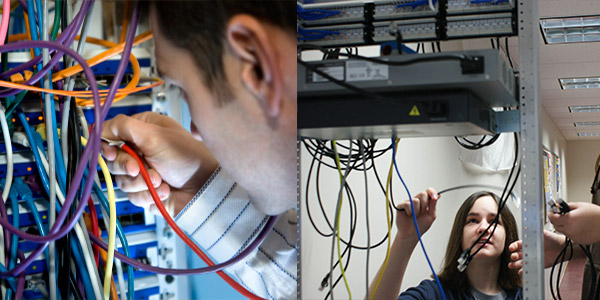ITI in Network Technician
Network Technician is a technical network vocational trade. The duration of trade is six months or one semester. Students are told/taught about so many topics during class hours like how to identify, troubleshoot and resolve problems; desktop systems, District network Internet and other computer technology; troubleshoot and solve local-area network problems; provide technical support to end-users; regarding computer hardware and software; install, test, certify and troubleshoot networking cabling systems. They also introduced that how to install configured network equipment; provides technical expertise to end-users regarding optimal set-up for software, hardware and network use; install, configure, monitor and troubleshoot a wide range of network and data communications software and hardware; train users in various software applications and network-related procedures; provide work direction for student assistants; and perform related work as required and the like others. Trade is career orienting in nature that opens many job opportunities after its successful passing as every business has been using computer and internet in their daily activities. There are many ITIs in the country offering this trade.
Skills Required
- They should possess good interpersonal skills to communicate with network users and other information systems professionals.
- Students should have good analytical and problem-solving skills to assess network performance and recommend changes.
- They also need project management skills to ensure that new installations or network upgrades do not disrupt normal work.
Syllabus
- Visit to different sections of the Institute. Safety precautions, Electrical Safety. Demonstration and operation of Fire Extinguishers. Demonstration of Artificial Respiration. Safety and occupational health: Effects of Cramped room and ill-light working environment. Effects of improper sitting posture. Effects of improper lifting of posture of Heavy Components Electric shock for the user due to electrical problem. Software Hardware security Password, Locked Room, Sealed PC, User last Modified Environment: Pollution of environment due to e-waste. Waste recovery facility through inter industry exchange. Removing Dust particles on the keyboard and other components.
- Visit to establishments with general purpose and special purpose computers. Visit to Computer centers installed with Mini and Micro computers. Familiarisation with different type of Computers. Type of applications, operating systems, Software use in the establishments. CMOS Setup, HDD Types, IRQ, Boot sequence, Passwords-User and Supervisor.
- Identification of different peripheral devices. Practice of soldering. Connecting and dismantling cords, cables and peripheral devices. Identifying and handling of different types of Latest removable storage devices and CDs/DVDs. Understanding the keys and their functions in keyboard. Keyboard operation and practicing mouse. Connecting different types of peripherals Installing different types of Printer.
- Booting the computer under DOS and Windows. Using different computer peripherals. Self-test for different Printers. Keyboard and mouse practice.
- Introduction to Windows.
- Advanced Windows.
- Motherboard.
- Expansion Cards.
- Installation of Operating Systems – DOS, Windows XP / Vista / 7 or any other latest version and Unix/Linux. Installation of network Operating system and basic network configuration. Identification of Network tropologies, network devices, types of protocols used, types and network media used.
- Installing & Configuring a Peer-to-Peer Network using Windows Software. Making cables by crimping.
- Installing & Configuring Windows 2003 / latest Linux based Server.
- Installing & Configuring Novell Netware Server.
- Structured cabling and using I/O Box. Setting up Nodes.
- Physically connecting and running the Network. Troubleshooting the Network.
- Configuring Print Server. Network Administration Functions. Identification and using the Network components. Cascading Hubs.
- Exposure and using Internet.
- Installing and Configuring Internet Connection on a PC using PSTN.
- Installing and Configuring Internet Connection on a PC using ISDN.
- Installing and Configuring Internet Connection on a PC using ISDN. Installing Proxy Server. Setting E-mail accounts.
- Virtual Networking Practice through simulators.
Eligibility & Admissions
- 10th Class Passed.
- Performa for admission may be obtained from the respective State Directorate dealing with Craftsmen Training Scheme or from the Principals of the concerned Industrial Training Institutes/ centers conducting training programme under Craftsmen Training Scheme.
Higher Studies
- Advance Diploma in Computer Hardware and Networking (ADCHN).
- Advance Diploma in Hardware Networking and Security (ADHNS).
Job Prospects
- Students after passing trade successfully can work in companies such as computer companies, manufacturing companies and the like other network using industries on different positions.
- It is also beneficial for them as it gives them good base for further higher studies like Diploma and Degree courses.
- They can also open/run network repairing shop after it on private basis in form of self-employment.
 Courses and Colleges after 10th After 10th, What Next?
Courses and Colleges after 10th After 10th, What Next?








